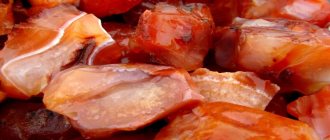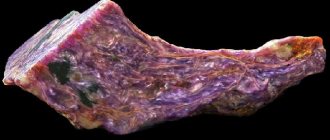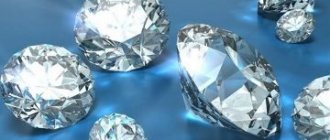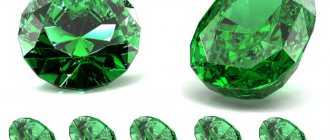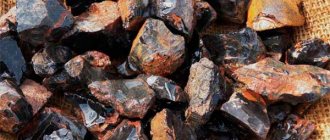Obsidian is a stone that can easily be found where a volcanic eruption has occurred.
This is nothing more than volcanic glass - frozen lava. The material has attracted the attention of people for a long time - already in the Stone Age, weapons and jewelry were made from it. The mineral was valued both for its physical qualities: hardness and sharp chips, and for its “fiery” origin. Although arrows, spears, and knives made from this rock were replaced first by bronze and then by steel, the crystal is still valued. Firstly, the stone is easily polished and can be processed in skillful hands. And secondly, obsidian has properties of a different nature - magical and healing. We will talk about them in this article, and also explain who the obsidian talisman is suitable for and who is contraindicated.
Origin of obsidian
The mineral chip is very sharp, and it is easy to process. Therefore, obsidian weapons were already in use in the Stone Age. In the Bronze and Iron Ages, volcanic crystals began to decorate the interiors of palaces, tombs, and temples. According to legend, it was brought to Europe from Ethiopia by a warrior named Obsidius, from whom the name of the stone comes from in all European languages.
There are legends that the gem is Satan’s claw. According to one of these legends, Cain killed Abel with a volcanic stone. Another myth says that the devil broke off his claws when he was cast out of heaven. Obsidian was also called the stone of the dead. Volcanoes, in the vents of which it is often found, were considered in ancient Greece and Rome to be gateways to the afterlife.
In Central America, warriors made macuahuitli, a type of sword made from obsidian. With such a wooden club, lined with sharp spikes-blades, they got used to cutting off the heads of the horses of the conquistadors, but could not pierce the steel armor. Still, the mineral may be sharper than steel, but much more fragile. Macuahuitl was enough for a maximum of one battle - pieces of volcanic glass chipped and broke.
Obsidian has a rich and interesting history. There is more than one legend about its origin.
The North American Indians called the crystal the tears of the Apaches. Legend has it that when the most powerful warriors of the tribe were surrounded by enemies, they threw themselves into the mouth of a volcano so that their opponents would not capture them as slaves. According to one version of the legend, obsidian is the tears of these warriors who entered the kingdom of the dead alive, and now miss their family and friends. On the other hand, the tears that their mothers, wives, and daughters shed for the brave men.
In modern times, craftsmen from the Faberge jewelry house rediscovered obsidian for European high society. By that time, the popularity of the stone had long faded, but the skillful jewelry of the best jewelers revived it. During the obsidian boom, even the most distinguished ladies and gentlemen wore the mineral. Subsequently, the furor subsided, the stone went out of fashion, but not completely - it is still appreciated.
Volcano energy
So, obsidian was born in the very heart of our planet - it is magmatic glass, a mineral of volcanic origin, which has a very deep, pronounced and rich palette.
According to ancient legend, obsidian was brought to Western Europe by the Roman legionnaire Obsidius, who miraculously survived a terrible battle.
Since then, the stone has gained fame as a saving amulet and has become widespread. The famous seer Vanga said that obsidians are the black-scorched wings of an angel saving people from the fire of the underground Hell.
- For many centuries, it has been officially allowed to depict the faces of saints and apply prayers from this volcanic mountain rock - and this is very rare.
- Thin plates-pendants with the prayer “Guardian Angel” have become widespread throughout the world - they are powerful protectors from any negative impact.
- Numerous legends tell about miraculous obsidian amulets that protect a person from sins and committing bad deeds.
- The stone repels bad people from its owner and eliminates negative thoughts.
Magic balls are made from obsidian, which are simply mystically beautiful - the surface of the mineral shimmers and mesmerizes, especially when the stone is turned in different directions. Mysterious images reflected on the glassy surface of the ball seem to float away into nowhere as it rotates.
And they are replaced by more and more new faces and figures, like unpredictable turns of human destiny. Experienced magicians use obsidian balls when performing magical rituals and fortune telling: in the twilight of burning candles, they rotate them clockwise, carefully observing the images that arise, unraveling their meanings.
Where is the mineral mined?
The stone is formed during eruptions, when molten rocks ejected by a volcano freeze so quickly that they do not have time to crystallize. From a chemical point of view, obsidian is silicon oxide.
Obsidian is not classified as a precious stone, or even a semi-precious one.
The mineral is mined in regions where volcanoes actively erupt:
- in Central America - El Salvador, Guatemala, Mexico;
- in Japan;
- in the Canary Islands;
- in Iceland;
- in Indonesia;
- in Italy on the island of Sicily;
- in Russia there are deposits on the Kuril Islands and Kamchatka.
The reserves of the gem can be considered inexhaustible. Volcanic eruptions occur regularly and will continue to occur for a very long time. Therefore, obsidian is not classified as a precious stone, or even as a semi-precious one.
Several unusual varieties are mined in Mexico, such as red or mahogany obsidian. There are also golden specimens there, which have no analogues anywhere in the world. Occasionally you come across multi-colored stones with a matte tint, which are highly valued as an ornamental material.
Types and colors of obsidian
The mineral shines like glass and is easy to process. Completely transparent obsidian is extremely rare; most often it is translucent. The most common stone colors are:
- Black stone is the most widespread variety; it is the one most often thought of when talking about a mineral. It owes its hue to inclusions of magnetite.
- Brown obsidian, known as the gem that brings harmony. It also promotes spiritual growth.
- A silvery gem, which is called the stone of spirits, shamans, and sages.
Rock varieties with patterns are classified into a separate group.
- A peanut stone that, when cut, resembles a nut.
- Rainbow obsidian, the rarest variety. Its shimmers and streaks of green, blue, and gray colors resemble spilled gasoline.
- Snowy obsidian - silvery inclusions in its black thickness look like snowflakes.
Finally, the third group of obsidian varieties is called "shin". These are solid black and brown stones that shimmer when you look at them from different angles.
- A green stone that has an olive tint.
- Californian variety, also known as blue.
- Golden obsidian, brownish, giving off a metallic sheen. A subspecies of this tire, which is mined in the Caucasus, is called the “cat's eye” gem.
- Plum Shin, or purple mineral, with a reddish and violet tint.
Physico-chemical description
Obsidian is solidified volcanic glass. Or, in other words, glassy rock of igneous origin, consisting mainly of silicic acid lava.
Properties of obsidian:
- the chemical composition includes 70–75% silica SiO2, 25–30% total magnesium oxide MgO and magnetite Fe3O4; there is no water in the content;
- average hardness – 5-6 according to Mohs;
- high density – 2.5-2.6 g/cm3;
- great fragility;
- glassy luster with iridescence;
- dense, amorphous, non-crystalline structure;
- translucent, occasionally transparent;
- The color is dark due to the magnetite content: black-resin, red-brown, greenish or grayish. There are stones with striped colors, indicating the direction of lava flow, as well as with streamy, spotted ones.
Color
The color of the stone due to the smallest particles of magnetite is mainly black, but, depending on the hardening conditions and chemical composition, there are also red-terracotta, brown, green, gray and other varieties, including alternating colors that are similar to decorative marble, which makes the mineral attractive for jewelry processing.
Its texture can also be heterogeneous - striped, streamy or spotted, and when polished and polished, a silvery-pearl luster or golden reflexes appear, giving the stone a more refined and noble appearance.
Use and care of stone
Of course, obsidian weapons are a thing of the past. It was used for one single reason - they did not know how to process metals. By itself, as a material for arrows or spears, stone is inferior to steel and even bronze. Yes, it is very sharp, but fragile. A broken or dull weapon can only be thrown out of it.
Obsidian is an ornamental material from which decorative elements, jewelry and weapons are made.
However, now obsidian blades and knives continue to be used, but not in war, but in microsurgery. Where it is important to make a thin, precise, neat cut (surgeries on the eyes, brain, heart), the stone becomes indispensable. Not all doctors, even in developed countries, can afford diamond instruments, but obsidian ones can easily be afforded.
Products made from obsidian are not only knives. This is an excellent craft material. Figurines are cut from gemstones, and luxurious reception halls are lined with them. Lighters, table sets, rosaries, and volcanic glass pendants look very impressive.
Necklaces and beads are also still popular. Not every stone, even among the more expensive ones, can boast such a rich, deep “appearance”. The gem shines brightly in the sun, creating a mystical, noble aura around the owner. This is why obsidian will never go out of style.
Do not forget that this material is glass, albeit volcanic. Obsidian jewelry requires careful, careful care. There are several rules that are best followed to ensure that the stone lasts a long time.
- You should not keep the gem in the same box with other jewelry. It is best to store it in a separate case, lined with soft fabric.
- When exposed to direct sunlight, the stone loses its rich obsidian color. Therefore, you should not wear it too often. At least don't wear it in plain sight.
- Protect your earrings, rings, and beads from bumps and falls. The gem not only breaks into pieces - its fragments are very sharp and dangerous to collect.
- The mineral loses its color characteristics if it sits in water for a long time, as well as under the influence of chemical reagents. Remove your jewelry when cleaning or even just washing dishes.
- The crystal needs to be cleaned from time to time. To do this, rinse it with cold water, then wipe dry with a soft cloth or sanitary napkin. The mineral should not be wet, otherwise its color and structure may be damaged.
How to distinguish obsidian from a fake
To distinguish a natural gem from a fake, you need to remember what obsidian looks like. Real stones have deep, rich colors, they are translucent and sparkle in the sun. If you hold it in your palms, it will remain cold, like most other minerals.
Only natural stone has the magical properties of a real “claw of Satan.”
If you try to scratch the crystal, it will leave a deep mark. At the same time, it will be clear whether they are selling you an original or a painted piece of plastic. Unfortunately, not every seller will allow you to conduct such an experiment, even if his product is completely natural.
There is another way to check the authenticity of volcanic glass. To do this, place it in water for two to three minutes. The color of the obsidian will change slightly, but will quickly return to normal if you immediately wipe the gem dry.
You should also pay attention to the amount the seller wants. The price of obsidian, especially rare ones with multi-colored inclusions, cannot be too low. For the best bracelets or beads made of rainbow volcanic glass, you will have to pay several thousand rubles.
It is especially important not to fall for scammers if you are buying more than just jewelry. Artificial stone does not have the magical properties of the real “claw of Satan”, and is also not suitable for lithotherapy. So you need to choose very carefully.
Color versions
Obsidians are found in nature in three main colors - black, gray and reddish-brown.
In addition, three more variations of the mixed color of the mineral can be named:
- snow obsidians - such stones are black in color and have small white spots, very similar to snowflakes;
- peanut - the pebbles contain inclusions resembling peanuts;
- iridescent - can vary from red, blue, green to blue shades. The illusion is created that the gem shimmers with all the colors of the rainbow. Rainbow obsidians in their cut resemble spilled oil. Stones of this type are elite, since there are not too many of them in nature.
The healing properties of the mineral
Our primitive ancestors knew that the mineral obsidian can alleviate many diseases. Modern lithotherapists confirm its healing properties and importance for human health.
- Volcanic glass protects against hypothermia, frostbite, and colds.
- The stone has a beneficial effect on the digestive tract. Thanks to its effect, ulcers heal, erosions and gastritis disappear, and nutrient absorption improves.
- A bracelet with obsidian, if worn on the left hand, can restore normal vascular tone. Thanks to this, pressure, both high and low, returns to “healthy” numbers.
- The gem heals the nervous system. Its energy helps patients recover faster from strokes and traumatic brain injuries. The crystal also helps with neuroses, depression, and anxiety.
- If you keep the stone close to the places of fractures, sprains, and cuts, it can speed up the tissue healing process.
- Obsidian looks like a piece of the night sky. Perhaps this is why it is believed that it saves from the ailments of the dark. Such a talisman can act no worse than a dream catcher. For example, children who have a gem hanging over their cradle are less tormented by nightmares, fear of the dark, and enuresis.
Do not overuse volcanic glass. If you wear it for too long, it can lead to irritability, blood pressure surges, poor sleep and appetite.
If you start wearing a gem, then remember that its abilities are best enhanced by a frame made of copper or silver.
Price
The price of obsidian depends on many factors: complexity of finishing, size, shape, type, cut. For a miniature stone, cabochon or pendant of 2–3 cm, you can pay from 100 to 700 rubles. The peanut or snow varieties are more commonly used here.
The price of one bracelet reaches 2,000 rubles, provided that it is made only from obsidian stone without metal.
Small-diameter mineral beads cost about 1,500 rubles; the larger the size of the bead, the more expensive the product. The price of a small sphere is 800 rubles or more.
Rings and earrings are usually made with a frame made of precious or base metal, so the price of the product here starts from 2,000 rubles.
Regular obsidian can be purchased at an affordable price. Iridescent and rare valuable samples are valued much more expensive.
The magical properties of obsidian
In terms of magical properties, obsidian stone is among the leaders. Its features are not too diverse, but they more than pay off with powerful energy. This is the talisman of seers and sages. It helps you see the world in all its aspects. Anyone who has achieved harmony with a volcanic amulet will always find a way out of the most difficult situations. The mineral releases emotions and feelings, even those that have long been stored in the depths of the soul.
According to Eastern beliefs, a crystal is capable of revealing to the wearer the secrets of his previous incarnations and helping to work through karmic traumas. Meditation on obsidian “eyes” is psychologically difficult work, but thanks to it you will be able to overcome complexes and deep-seated mental problems.
If you have already freed yourself from psychological trauma, then the gem will begin to reveal to you the secrets of the universe. The talisman can make the owner attractive to people. He will become more sensitive to their joys and sorrows, which is necessary for a psychologist or fortune teller. Thanks to the stone, you can advance very far in spiritual development, find inspiration, original ideas, and strengthen your connection with the astral plane.
For spouses who wear obsidian rings as wedding rings, the mineral gives harmony in family life. It helps to maintain fidelity, maintain romance and passion in long-term relationships, and eliminates scandals and mistrust. Shamans, psychics, and magicians will be able to establish contact with the spirits of the elements and higher powers. Clairvoyants will improve their abilities and see clearer and more accurate pictures of the possible future.
Who is obsidian suitable for according to their zodiac sign?
First of all, among those for whom obsidian stone is suitable, astrologers name the following signs:
- Aquarius;
- Capricorn;
- Twins;
- Sagittarius.
Thanks to the gem, these people will become more decisive and at the same time lucky. The fiery energy of the stone will help them realize their wildest dreams and achieve success. It will be very easy to achieve harmony with volcanic glass; you just need to take care of the stone and protect it from damage.
When purchasing an obsidian talisman, consider compatibility with the stone.
On the contrary, Aries , Libra , Virgo , Taurus , Cancer, and Leo . It will make them too dreamy, flighty and out of touch with reality. This is fraught with problems in your personal life, at work, in relationships with friends.
Separately, it should be said about the features of the mineral for Scorpio . On the one hand, volcanic glass will help him find his inner core, become stronger and braver. For a shy person born under this sign, the gem will become a real lifeline. But those Scorpios who do not suffer from excessive modesty and gentleness will be made by the stone too selfish, authoritarian and cynical.
As for other signs, obsidian is neutral in relation to them. If you wear a talisman with a satanic claw too often, this is fraught with conflicts with others, withdrawal from reality, depression, and neuroses. But a mineral with which you have achieved harmony and wear only occasionally will definitely contribute to spiritual growth.
